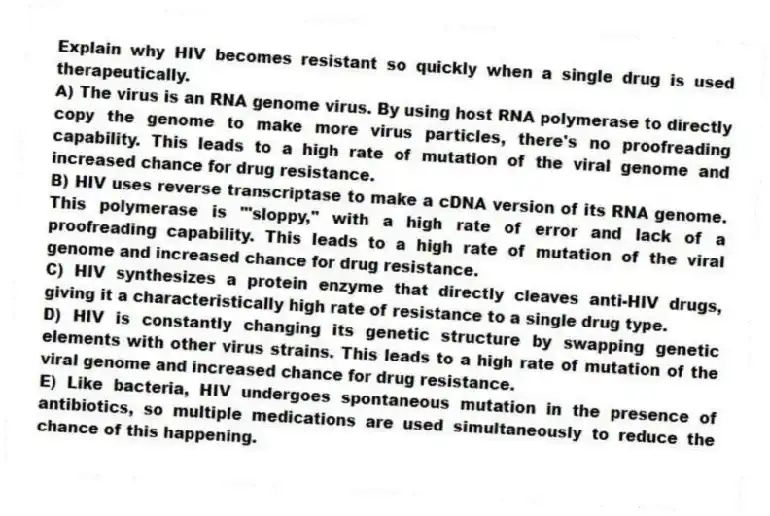
Explain why HIV becomes resistant so quickly when a single drug is used therapeutically.
A) The virus is an RNA genome virus. By using host RNA polymerase to directly copy the genome to make more virus particles, there's no proofreading capability. This leads to a high rate of mutation of the viral genome and increased chance for drug resistance.
B) HIV uses reverse transcriptase to make a cDNA version of its RNA genome. This polymerase is "'sloppy," with a high rate of error and lack of a proofreading capability. This leads to a high rate of mutation of the viral genome and increased chance for drug resistance.
C) HIV synthesizes a protein enzyme that directly cleaves anti-HIV drugs, giving it a characteristically high rate of resistance to a single drug type.
D) HIV is constantly changing its genetic structure by swapping genetic elements with other virus strains. This leads to a high rate of mutation of the viral genome and increased chance for drug resistance.
E) Like bacteria, HIV undergoes spontaneous mutation in the presence of antibiotics, so multiple medications are used simultaneously to reduce the chance of this happening.
Correct Answer:
Verified
Q108: Would you expect the number of virions
Q109: Spongiform encephalopathy occurs in all of the
Q110: Why are viroids resistant to nucleases?
A) Having
Q111: You add an unknown phage to a
Q112: Capsids are made of a number of
Q114: An antibiotic is added to a culture
Q115: Bacteriophages, unlike animal viruses, often have special
Q116: Why do animal viruses have envelopes and
Q117: Prions are
A) a form of RNA virus.
B)
Q118: Infective and non-infective viruses may be distinguished
Unlock this Answer For Free Now!
View this answer and more for free by performing one of the following actions

Scan the QR code to install the App and get 2 free unlocks

Unlock quizzes for free by uploading documents